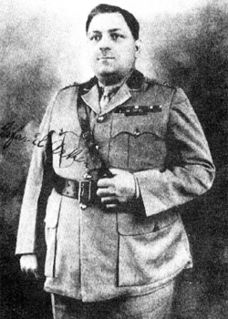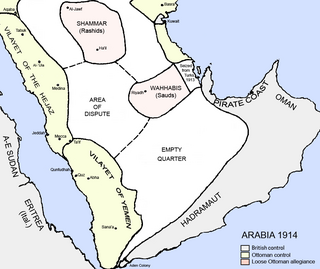
Faisal I bin Hussein bin Ali al-Hashemi was King of the Arab Kingdom of Syria or Greater Syria in 1920, and was King of Iraq from 23 August 1921 to 1933. He was the third son of Hussein bin Ali, the Grand Sharif of Mecca, who had proclaimed himself King of the Arab lands in October 1916.

The Hashemites are the ruling royal family of Jordan. The House was also the royal family of Syria (1920), Hejaz (1916–1925) and Iraq (1921–1958). The family belongs to the Dhawu Awn, one of the branches of the Hasanid Sharifs of Mecca – also referred to as Hashemites – who ruled Mecca continuously from the 10th century until its conquest by the House of Saud in 1924. Their eponymous ancestor is Hashim ibn Abd Manaf, great-grandfather of the Islamic prophet, Muhammad.

Ja'far Pasha al-Askari served twice as prime minister of Iraq: from November 22, 1923, to August 3, 1924; and from November 21, 1926, to December 31, 1927.

The Hejazrailway was a narrow-gauge railway that ran from Damascus to Medina, through the Hejaz region of Saudi Arabia, with a branch line to Haifa on the Mediterranean Sea. It was a part of the Ottoman railway network and the original goal was to extend the line from the Haydarpaşa Terminal in Kadikoy beyond Damascus to the holy city of Mecca. However, construction was interrupted due to the outbreak of World War I, and it reached no further than Medina, 400 kilometres (250 mi) short of Mecca. The completed Damascus to Medina section was 1,300 kilometres (810 mi).
The McMahon–Hussein Correspondence was a series of letters exchanged during World War I in which the British government agreed to recognize Arab independence after the war in exchange for the Sharif of Mecca launching the Arab Revolt against the Ottoman Empire. The correspondence had a significant impact on Middle Eastern history during and after the war, and a dispute over Palestine continued thereafter.

Hussein ibn Ali al-Hashimi was a Hashemite Arab leader who was the Sharif and Emir of Mecca from 1908 and, after proclaiming the Arab Revolt against the Ottoman Empire, King of the Hejaz from 1916 to 1924. At the end of his reign he also briefly laid claim to the office of Caliph. He was said to be a 37th-generation direct descendant of Muhammad as he belongs to the Hashemite family.
The Sharif of Mecca or Hejaz was the title of the leader of the Sharifate of Mecca, traditional steward of the holy cities of Mecca and Medina and the surrounding Hejaz. The term sharif means "noble" in Arabic and is used to describe the descendants of Prophet Muhammad's grandson al-Hassan ibn Ali.

Ali bin Hussein, GBE was King of Hejaz and Grand Sharif of Mecca from October 1924 until he was deposed by Ibn Saud in December 1925. He was the eldest son of Sharif Hussein bin Ali, the first modern King of Hejaz, and a scion of the Hashemite family. With the passing of the kingship from his father he also became the heir to the title of Caliph, but he did not adopt the khalifal office and style.
The Damascus Protocol was a document given to Faisal bin Hussein on 23 May 1915 by the Arab secret societies al-Fatat and Al-'Ahd on his second visit to Damascus during a mission to consult Turkish officials in Constantinople.
Medina, an Islamic holy city in Arabia, underwent a long siege during World War I. Medina was at the time part of the Ottoman Empire. In the war, the Ottoman Empire sided with the Central Powers. Sharif Hussain of Mecca revolted against the caliph and the Ottoman Empire which, under the leadership of the nationalistic Young Turks, had ignored the wishes of the Caliph and sided with the Central Powers. Hussain instead sided with the British Empire. T. E. Lawrence was instrumental in this revolt. Hussain occupied Mecca and besieged Medina. It was one of the longest sieges in history that lasted till even after the end of war. Fahreddin Pasha was the defender of Medina. Some celebrated him as "the Lion of the Desert" despite the suffering of those who remained in Medina. The siege lasted two years and seven months.

The Battle of Mecca occurred in the Muslim holy city of Mecca in June and July 1916. On June 10, the Sharif of Mecca, Hussein bin Ali, the leader of the Banu Hashim clan, started a revolt against the Ottoman Caliphate from this city. The Battle of Mecca was part of the Arab Revolt of World War I.

The Arab Revolt started by Sherif Hussein ibn Ali had a series of campaigns, starting from Mecca in June 1916. Here is a list of these campaigns:
The Sharifian Caliphate was an Arab caliphate proclaimed by the Sharifian rulers of Hejaz in 1924, in lieu of the Ottoman Caliphate.

The Sharifate of Mecca Arabic: شرافة مكة Sharāfa Makka) or Emirate of Mecca was a state, non-sovereign for much of its existence, ruled by the Sharifs of Mecca. A sharif is a descendant of Hasan ibn Ali, Muhammad's grandson. In Western sources, the prince of Mecca was known as Grand Sherif, but Arabs have always used the appellation "Emir".

The Vilayet of the Hejaz refers to the Hejaz region of Arabia when it was administered as a first-level province (vilayet) of the Ottoman Empire. At the beginning of the 20th century, it reportedly had an area of 96,500 square miles (250,000 km2). The Hejaz included all land from the southern border of the Vilayet of Syria, south of the city of Ma‛an, to the northern border of the Vilayet of Yemen, north of the city of Al Lith.
This is a timeline of major events in the history of the modern state of Jordan.
The First Saudi–Hashemite War, also known as the First Nejd–Hejaz War or the al-Khurma dispute, took place in 1918–19 between Abdulaziz Ibn Saud of the Emirate of Nejd and the Hashemites of the Kingdom of Hejaz.

The Ottoman era in the history of Arabia lasted from 1517 to 1918. Ottoman degree of control over these lands varied over the four centuries with the fluctuating strength or weakness of the Empire's central authority.













